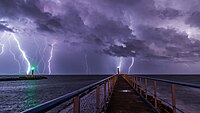
Photo from wikipedia
The effectiveness of damaged building investigation relies on rapid data collection, while jointly applying an unmanned aerial vehicle (UAV) and a backpack panoramic imaging system can quickly and comprehensively record… Click to show full abstract
The effectiveness of damaged building investigation relies on rapid data collection, while jointly applying an unmanned aerial vehicle (UAV) and a backpack panoramic imaging system can quickly and comprehensively record the damage status. Meanwhile, integrating them for generating complete 3-D point clouds (3DPCs) is important for further assisting the 3-D measurement of the damaged areas. During the 2016 Meinong earthquake (Taiwan), the system collected multiview aerial images (MVAIs) and ground panoramic images of two collapsed buildings. However, due to the spatial offsets of the spherical camera result in nonideal panoramic images (NIPIs), an appropriate spherical radius has to be chosen to reduce the distance-related stitching errors. In order to evaluate the impact of using NIPIs for 3-D mapping, the geometric accuracy of the 3-D scene reconstruction (3DSR) and usability of the 3DPCs were assessed. This study introduces the stitching errors of panoramic images, uses sky masks for successful 3DSR, and obtains clean point clouds. It then analyzes the usability of point clouds that were obtained from only NIPIs, only MVAIs, and their integration. The analysis shows that NIPIs have more rapid processing efficiency than their unstitched original images and can increase the completeness of point clouds at the building’s lower floor, while MVAIs can reduce the stitching errors of NIPIs to an acceptable range. Therefore, integrating both images is necessary to achieve rapid and complete point cloud generation.
Journal Title: IEEE Geoscience and Remote Sensing Letters
Year Published: 2022
Link to full text (if available)
Share on Social Media: Sign Up to like & get
recommendations!